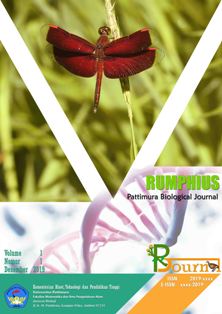Analysis of the Knowledge Level of Breeders of Native Chickens on Nusalaut Island
Abstract
The purpose of the research was to investigate the knowledge breeders of the native chicken in Nusalaut island in relation to good native chicken production practices. Both villages and respondents were selected used purposive sampling method. The variables were knowledge of the farmers, sex, age, education, household dependency rate, length of experience and the level of income from main job. The results showed that majority (72 %) respondents attained primary school, average dependency rate 4.9 ± 1.75 persons, majority (70 %) low income, more men possessed high knowledge than women (p = 0.047), length of experience affect knowledge significantly (p=0.184) and education affect knowledge highly significantly. It was concluded that although native chicken breeders have good knowledge about chicken production in overall, but there are certain knowledge gaps on feeding and controlling diseases.
Downloads
References
Abdulhak, I., & Darmawan, D. (2013). Educational Technology. Bandung: PT. Rosdakarya Youth.
Aziz, F. F. (2019). Financial Feasibility Analysis of Super Kampung Chicken Farming Business (Case Study of Suparlan Farm in Jojog Village, Pekalongan District, East Lampung Regency). Journal of Animal Husbandry, 3(1), 11-15.
Das, B. (2013). Diffusion of Old Information and Communication Technologies in Disseminating Agricultural Knowledge: An Analysis of Farmers’ Income. African Journal of Science, Technology, Innovation and Development, 5(3), 250-262, https://doi.org/10.1080/20421338.2013.817044
Hayanti, S. Y. (2014). Technical Instructions for Cultivating Superior Village Chickens (KUB) of the Agricultural Research and Development Agency in Jambi Province. Jambi: Agricultural Technology Assessment Agency (BPTP).
Hidayat, C., & Asmarasari, S. A. (2015). Native chicken production in Indonesia: a review. Jurnal Peternakan Indonesia, 17(1), 1-11. https://doi.org/10.25077/jpi.17.1.1-11.2015
Kazemi-Lomedasht, F., Yamabhai, M., Sabatier, J. M., Behdani, M., Zareinejad, M. R., & Shahbazzadeh, D. (2019). Development of a human scFv antibody targeting the lethal Iranian cobra (Naja oxiana) snake venom. Toxicon, 171, 78-85. https://doi.org/10.1016/j.toxicon.2019.10.006
Koentjaraningrat. (1989). Pengantar Ilmu Antropologi. Jakarta: Penerbit Rineka Cipta.
Mangkuprawira, S. (2004). Manajemen Sumber Daya Manusia Strategi, Jakarta: Ghalia Indonesia.
McLeod, N. M. & Keenan, M. (2021). Towards a consensus for classification of mandibular condyle fractures. Journal of Cranio-Maxillofacial Surgery, 49(4), 251-255. https://doi.org/10.1016/j.jcms.2021.01.017
Mulyasa, E. (2014). Manajemen Berbasis Sekolah: Konsep, Strategi dan Implementasi. Bandung: Remaja Rosdakar.
Mustaqim, M., Sari, W. N., & Fajri, T. I. (2023). Implementation of an Integrated Mobile Livestock Service Program at the Livestock and Animal Health Department of Aceh Province. Devotion: Journal of Research and Community Service, 4(12), 2232-2239. https://doi.org/10.59188/devotion.v4i12.604
Padmaningrum, D., & Widyas, N. (2021). The role of local knowledge system in enhancing Peranakan Etawa goat farm. IOP Conf. Series: Earth and Environmental Science, 9(2), 012-042. https://doi.org/10.1088/1755-1315/902/1/012042
Pramudyati, Y. S., & Agung, P. (2009). Raising Laying Breed Chickens. South Sumatra: GTZ Merang REDD Pilot Project.
Purwanto, B. M. (2002). The Effect of Salesperson Stress Factors on Job Performance. Jurnal Ekonomi dan Bisnis Indonesia, 17(2), 150-169.
Rogers, E.M. (2003). Diffusion of innovations (5th Ed.). New York: Free Press.
Soekartawi. (2005). Prinsip dasar komunikasi pertanian. Jakarta: Penerbit Universitas Indonesia (UI-Press).
Trisiwi, H. (2016). Effect of Different Feed Protein Levels during the Starter Period on the Appearance of Super Village Chickens. Journal Integrated Animal Husbandry Science, 4(3), 256-262.
Copyright (c) 2024 Valda Petrosina Selubun, Abraham Tualessy, Heryanus Jesajas

This work is licensed under a Creative Commons Attribution-NonCommercial-ShareAlike 4.0 International License.
Authors who propose a manuscript and have it approved for publication know that the manuscript will be registered and become part of the RPBJ. Authors and readers understand that this journal is open and all its contents can be accessed freely, provided that RPBJ is still listed as the source of information. The hope is that this journal can become a vehicle for exchange and scientific knowledge for society and the scientific community, especially in the field of Biology and other branches of science.









